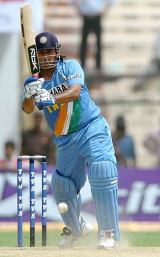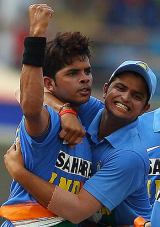Shining through
Dileep Premachandran spoke to Greg Chappell to find out more about India's ODI reversal of fortune
Dileep Premachandran
08-May-2006
|
|

|
As Mahendra Singh Dhoni adjusted his helmet straps and prepared to head to the middle, Greg Chappell asked him if he thought he could see it home. The asking rate was climbing towards seven an over with 99 needed, but there was no trepidation in Dhoni's voice as he said yes. "Will you be there at the end?" asked Chappell. Again, the reply was in the affirmative. "Just give me ten balls to play myself in," said Dhoni. "If I'm still there then, I'll be there till the finish."
Dhoni eked out four from the first 10 balls that he faced at the Gaddafi Stadium. Then, Umar Gul pitched one on a length and watched bemused as it was whiplashed to the cover fence. A lone shot can seldom change much - unless we're talking of grassy knolls and President Kennedy - but that one devastating arc described by Dhoni's bat would resonate through the rest of a series that was then poised at 1-1. He finished with 72 from 46 balls, transforming an improbable chase into a romp. Yuvraj Singh batted beautifully at the other end for his 79, but the climactic stages were all about Dhoni and his gift for unorthodox but chillingly effective strokeplay.
Sitting by the backwaters in Kochi, Chappell's face breaks into a half-smile as he remembers that, and vignettes from other chases. Not a man given to hyperbole, he can get animated when he talks about Dhoni. "Who've you ever seen hit an attempted yorker for six before?" he asks. "I don't know anyone in the world who could pick a ball out of the blockhole and hit it for six. It comes from his having played tennis-ball cricket; he's an awesome talent."
In Dhoni's success can be seen the underlying reasons for India's one-day renaissance. Until a couple of seasons ago, Dhoni and others like Kerala's S Sreesanth hadn't even played much against top-notch Indian opposition, leave alone the titans of world cricket. Both Dhoni and Sreesanth played for Plate teams in the Ranji Trophy, and their development at the highest level has been nothing short of staggering. "They've been challenged with things they've never seen before," says Chappell. "You don't get three international-class fast bowlers in a Plate team. People say England were a weakened side, but the bowling attack was still solid."
Mastering the chase was akin to reinventing the wheel for a team that had appeared clueless in ODIs following the surge to the World Cup final in 2003. With all due apologies to Hansie Cronje's side, India were the quintessential chokers - one outright win in 15 finals under Sourav Ganguly - and the motto when chasing usually appeared to be All Fall Down.
Something needed to be done, and Chappell and Dravid worked on the premise that the best way to overcome fear was to confront it. The opposition were asked to bat even when conditions cried out for India to make first use of the pitch. As Chappell puts it: "The only way we were going to be successful was to face the demons."
|
|
The conquest of those demons was aided by the emergence of a younger core of players unscarred by pitiful failures. Against Sri Lanka at Pune in the fourth match of the series, India slipped to 180 for 6, needing another 82 for victory. Dhoni had only the unheralded Suresh Raina for company, but the two ran the fielders ragged as they eased to the target. Dhoni's batting that day was a revelation, with attacking instincts fettered till the very last, when two joyous sixes finished things off.
That adaptability has made him one of the most feared batsmen in the world. "His temperament and personality are incredible," says Chappell. "A few months ago, he was just a basher. Now he's one of the best finishers, and can also bat up the order. We can depend on him to finesse an innings, batting like [Michael] Bevan used to. But he also has the big shots that Bevan didn't have."
Dhoni has also had a huge role to play in Project Allrounder. JP Yadav was tried briefly at the start of the season, but instead of casting the net wide into the domestic circuit, the team management then looked within. Irfan Pathan's batting in Tests had caught the eye because of his ability to play impressively straight while packing a mighty punch, and the decision to use him as a floater in the batting order has worked a treat. Similarly, Yuvraj and Sachin Tendulkar - until the shoulder became too painful - were encouraged to work on their bowling.
The faith reposed has been more than repaid. Pathan has made vital incisions with the new ball in virtually every game, and contributed immensely with his clean hitting when sent up the order. Yuvraj, apart from metamorphosing into a model of consistency with the bat, has also delivered the odd telling spell with the ball, while continuing to pull off sensational catches at point.
It hasn't happened overnight, and the skeptics have had a field day dissecting and mocking some of the training drills used. "What the hell are they doing?" was a common refrain as players negotiated obstacle courses and other innovations not seen before at cricket training. "What we were doing was developing areas that needed work," says Chappell. "One thing we identified quickly was that we weren't fit enough, mentally or physically, to last 50 overs. Leg strength was something that needed improving. Agility, bending and twisting, was another. Indians are not as naturally athletic as some other races, so we devised some drills aimed at "tricking" them into getting better. We spent months seemingly punishing these guys, and having to explain to them why it was needed."
It hasn't had the same effect on everyone either. Virender Sehwag got more pudgy, even as the runs became thinner on the ground for him. But both he and Mohammad Kaif have been persisted with. "Individuals are safer in a healthy team," says Chappell. "We can carry players longer, and you have more leeway to protect them. You'd rather give a proven player one game too many than one game too few."
Sehwag's prolonged run-drought has elicited philosophical responses from both captain and coach, who acknowledge that teams have started targetting his frailties successfully. Both agree that remedial measures in the year leading up to the World Cup could benefit both player and team immensely. Chappell harks back to Vivian Richards when he analyses Sehwag's struggle.
|
|

|
"Initially, during the World Series, we had a lot of success targetting his weaknesses, but in the long run, we turned him into a better allround player. I think that's what Veeru's going through at the moment. He's got through till now with natural ability and his strengths."
Sehwag turned a small corner in Abu Dhabi with a gritty 73, and the team itself is unrecognisable from the rabble of last season. Since Dravid was appointed one-day captain, there have been 18 wins in 24 outings - two of the losses were in dead rubbers - and the captain has often led the way, whether it be crashing 85 from 63 balls from No.5 in the opening game against Sri Lanka, or coming out to open against England and Pakistan. Allied to his inherent solidity is an increasing ability to innovate according to the situation, and Chappell says: "I think Rahul's a better player now, he's developed a better range of shots."
While Chappell's methods and man-management skills have been put under the microscope innumerable times, he himself sees Dravid as the true catalyst of change. "A lot of what we've attempted wouldn't have been possible without the support and courage of the captain, who has taken on different roles himself from time to time - like opening the batting in both Tests and ODIs," he says. "His captaincy has gone to another level, especially with regard to field placings. He also trusts his intuition more and more."
The ever-changing composition of the team and batting order has irritated many, but that strategy is likely to be persisted with until a group of 25 is whittled down to 14 a few months before the World Cup. And as Chappell says, staleness can afflict even the very best. "Last year, Australia stayed with a group, and didn't quite work out for them in the Ashes. They needed to inject new energy, and are now seeing the benefits. The energy could even come from a player who's been there before."
For all the progress, this is still an Indian team comprising largely raw talent, and patience will be as important as any tactics in the months ahead. At Kochi, Sreesanth, the local icon, was often distracted; trying to find friends and family in the crowd, and a visibly irritated Dravid had to keep shifting him. Chappell was more amused than anything else, telling Dravid: `You have a choice between a disciplined fielder who bowls medium pace, and someone who bowls fast and gets wickets for you'.
"They're just kids," says Chappell. "Some days, they will stuff up. That's part of learning." There are already some composed characters in there. At Delhi airport, during the seven-match jamboree against England, the team's flight was delayed by nearly four hours. The English fretted and fumed, and Chappell himself was agitated. But when he looked around him, his players were far from flustered. Some had their iPods out, others read, and a few others opened up their laptops. "They'd accepted the delay as just another part of life," says Chappell. "And if you're not fazed by life, why would you be fazed by chasing a target in a one-day match?"
To subscribe to Cricinfo Magazine, click here
Dileep Premachandran is features editor of Cricinfo